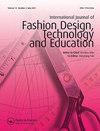Creative exploration: zero-waste fashion design practices with traditional Korean clothing
IF 2.2
Q3 BUSINESS
International Journal of Fashion Design, Technology and Education
Pub Date : 2023-05-04
DOI:10.1080/17543266.2022.2148293
引用次数: 0
Abstract
ABSTRACT The fashion industry is one of the sectors most responsible for environmental pollution and waste generation. Zero-waste design either minimises or prevents waste generation by efficient use of resources for sustainable growth with environmental responsibility. This paper reviews traditional clothing, focusing on pants, go (袴), from the Joseon Dynasty, an era that emphasised ‘oneness with nature’. It analyses their zero-waste design aspects and formative features and, in order to examine their eco-friendliness and aesthetic value applies these to three fashion designs. Sapok pants, pungcha pants and dan-sokgot were selected as design motifs because of their unique structures, creative construction methods and zero-waste aspects. Results demonstrate that the zero-waste patternmaking and composition methods significantly lowered the fabric waste rate, by 0.6–6%. In addition, new design silhouettes are presented by applying unique structural principles and recombining traditional patterns, and these offer highly effective and creative alternate zero-waste fashion design methods.创意探索:利用韩国传统服装进行零浪费的服装设计实践
时尚产业是造成环境污染和产生废物最多的行业之一。零废物设计通过有效利用资源,实现可持续发展,并对环境负责,从而最大限度地减少或防止废物产生。本文回顾了朝鲜王朝的传统服装,重点是裤子,强调“与自然合一”的时代。它分析了它们的零浪费设计方面和形成特征,并为了检查它们的生态友好性和美学价值,将这些应用于三种时装设计。由于其独特的结构、创造性的制作方法和零浪费的特点,我们选择了沙布裤、蓬茶裤和丹兜裤作为设计主题。结果表明,零浪费的制版和合成方法显著降低了织物的废品率,减少了0.6-6%。此外,通过运用独特的结构原理和对传统图案的重新组合,呈现出新的设计轮廓,这些都提供了高效和创造性的零浪费服装设计方法。
本文章由计算机程序翻译,如有差异,请以英文原文为准。
求助全文
约1分钟内获得全文
求助全文
来源期刊

International Journal of Fashion Design, Technology and Education
Arts and Humanities-Visual Arts and Performing Arts
CiteScore
3.10
自引率
0.00%
发文量
36
 求助内容:
求助内容: 应助结果提醒方式:
应助结果提醒方式:


